- Unit14 Jul 2010
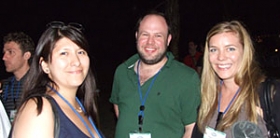
Members of the basal ganglia laboratories have presented at several international meetings over the summer.
IBAGS X (Tenth Triennial Meeting of the International Basal Ganglia Society) Long Branch, New Jersey (June 20th-24th).
Juan Mena-Segovia gave one of the lectures entitled 'Functional diversity in the pedunculopontine neurons that project to the basal ganglia: Implications for Parkinson's disease'
Unit members presented the following posters:
Doig, N.M., Moss, J & Bolam, J.P. (2010) Cortical and thalamic innervation of direct and indirect pathway medium-sized spiny neurons in mouse striatum. P-55
Ellender, T.J., Huerta-Ocampo, I., Capogna, M & Bolam, J.P. (2010) Histaminergic modulation of striatal function. P-90
Henny, P., Brown, M.T.C., Northrop, A., Micklem, B.R., Magill, P.J & Bolam, J.P. (2010) Structural bases of activity of identified dopaminergic neurons in the substantia nigra pars compacta. P-71
Huerta-Ocampo, I., Mena-Segovia, J & Bolam, J.P. (2010) In vivo characterization of direct and indirect medium sized spiny neurons (MSNs) located in the striatal matrix compartment and their innervation by cortical and thalamic afferents. P-15
Mallet, N., Micklem, B.R., Henny, P., Brown, M.T.C., Williams, C., Bolam, J.P & Magill, P.J. (2010) Elucidating functional dichotomy in the external globus pallidus: A major population of pallidal neurons specifically innervated striatum. P-84
Martinez-Gonzalez, C., Bolam, J.P & Mena-Segovia, J. (2010) Neurons containing calcium binding proteins are topographically organised in the pedunculopontine. P-173
Moss, J & Bolam, J.P. (2010) Anatomical analyses of glutamatergic and dopaminergic synapses of the rat striatum. P-171
Nakamura, K.C and Magill, P.J. (2010) Spontaneous activity of neurons in basal ganglia and cerebellar-recipient zones of the rat motor thalamus in vivo. P-96
Pienaar, I.S., Micklem, B.R., Martinez-Gonzalez, C., Stewart, R., Bolam. J.P & Mena-Segovia, J. (2010) Stereological estimation of the total number of neurons in the pedunculopontine nucleus and their topographical distribution. P-87
Pissadaki, E. K. & Bolam, J.P. (2010) Signal propagation and metabolic efficiency in the axons of the SNc dopamine neurons. P-115
Physiological Society Meeting in Manchester (30th June-2nd July)Paul Bolam gave a lecture entitled 'New results on thalamostriatal projections and their relationship with dopaminergic afferents' in a symposium at the Physiological Society Meeting in Manchester, "From striatal circuits to basal ganglia function: how recent experimental findings constrain our models"
7th Meeting of FENS (Amsterdam, July 3rd to 7th)Paul Bolam organised and chaired a symposium : "Select and Act: The role of the striatum in selection of behaviour". Peter Magill gave one of the lectures entitled 'Synchronised oscillations in the striato-pallidal network'. The symposium was attended by about 700 people
Members of several Unit labs presented posters at the meeting:
Bienvenu, T., Busti, D., Magill, P.J., Ferraguti, F. & Capogna, M. (2010) GABAergic cell types of the basolateral amygdala are differently modulated by hippocampal theta oscillations and noxious stimuli. 130.7
Dupret, D., O'Neill, J. Pleydell-Bouverie, B. & Csicsvari, J. (2010) Hippocampal population representation during a matching-to-multiple-places task. 025.12Hartwich, K., Massi, L. & Klausberger, T. (2010) Brain state dependent firing patterns of identified interneurons in the medial prefrontal cortex. 130.30
Lapray, D., Asede, D., Szabo, A., Nissen, W., Capogna, M., Somogyi, P. & Lamsa, K. (2010) Axonal variability of GABAergic ivy interneurons in the hippocampal CA1 area. 104.10
Lasztóczi, B. Tukker, J.J., Lapray, D., Klausberger, T. & Somogyi, P. (2010) Spike-timing of cholecystokinin containing hippocampal CA3 interneurons in relation to physiological network oscillations in vivo. 130.44
Magill, P.J., Sharott, A. & Mallet, N. (2010) Synchronised oscillations in the striatopallidal network. 122.2
Manko, M., Geracitano, R., & Capogna, M. (2010) The role of main intercalated nucleus of the mouse amygdala. 075.24
O'Neill, J., Pleydell-Bouverie, B., O'Neill, J. & Dupret, D. (2010) Oscillatory coupling between the hippocampus and medial entorhinal cortex during a working memory task. 087.14Pleydell-Bouverie, B., O'Neill, J., Dupret, D., Paulsen, O. & Csicsvari, J. (2010) Sharp wave events coordinate information transfer in the hippocampal-entorhial system during sleep but not during exploration. 087.18GABA Signalling and Brain Networks (FENS Satellite)Peter Magill attended and gave a lecture entitled 'Disturbed network activities of GABAergic basal ganglia projection neurons in Parkinsonism 'at a satellite symposium of the FENS meeting, an EMBO Workshop, "GABA Signalling and Brain Networks".
Slow Brain Oscillations of Sleep, Resting State and Vigilance (FENS Satellite)Juan Mena-Segovia gave a lecture entitled 'Impact of brainstem network activity on cortical dynamics during slow oscillations' at a satellite symposium of the FENS meeting (26th International Summer School of Brain Research on "Slow brain oscillations of sleep, resting state and vigilance"), organised by the Netherlands Institute for Neuroscience.
38th Meeting of European Histamine Research SocietyTommas Ellender presented a poster entitled "Histaminergic modulation of striatal function" at the 38th Meeting of European Histamine Research Society. This meeting was one of the casualties of the Icelandic volcanic ash earlier this year!
- Unit8 Jul 2010
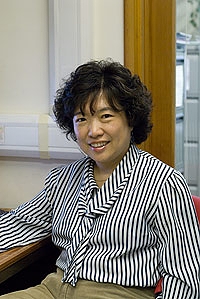
We welcome the return of Professor Limei Zhang from the Universidad Nacional Autonoma de Mexico for a short visit to Peter Somogyi. She will evalutate peptidergic subcortical innervation of the rodent hippocampus. Prof. Zhang has spent several years in the Unit previously and published papers from collaborative studies.
- Unit6 Jul 2010
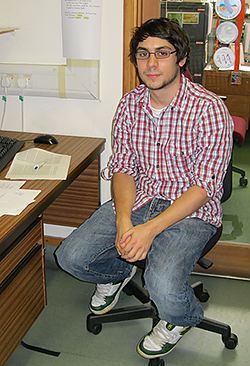
We are pleased to welcome Michael Crump as a visiting student to Professor Somogyi's lab. Michael has just graduated from University of Leeds where he did BSc Neuroscience and spent his industrial placement year working in the laboratory of Dr Steven Younkin at the Mayo Clinic Florida (http://www.mayoclinic.org/jacksonville/). He will become a Probationary Research Student studying towards a DPhil from October 2010 and explore septo-hippocampal relationships under the joint supervision of Peter Somogyi and Damien Lapray.
- Unit21 Jun 2010
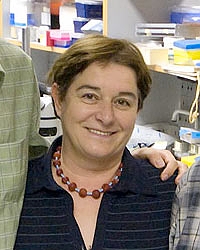
We are pleased to welcome back Klara Peto from St Istvan University, Budapest, Hungary for a return visit for ongoing collaborative work in Professor Somogyi's lab.
- Unit21 Jun 2010
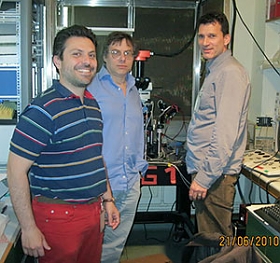
This week Marco Canepari (INSERM, Grenoble, France) and Jeremy Graham (Cairn Research Ltd, UK) are visiting Marco Capogna to set up voltage imaging equipment that it will be used to optically record synaptic signals from single neurons of acute slices.
- Unit16 Jun 2010
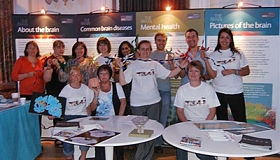
Jeff McIlhinneyreports on the Cheltenam Science Festival:
Ruth Faram and I served on the MRC stand at Cheltenham Science Festival which ran from the 9-14th June. We were joined by many members of the MRC from all over the UK, as can be seen from the picture. Large numbers of the public, the organizers of the festival thought another record breaking year, passed through the main hall enjoying the different exhibits. This year the emphasis at the MRC stand was on the brain, which suited Ruth and I well. The "Guess the weight of the human brain", the "Identify the brain disease from the scans" and the "Take the brain apart, and put it together again" exhibits all proved popular with all ages. As usual I was surprised by the interest shown by the wide range of ages in all of the exhibits, and by the appreciation shown by those we talked to about our work. Again several teachers were picking up ideas from the stands for future use in the classroom, so the benefit of the Festival is longer lasting than the event itself. Overall it was a thoroughly enjoyable experience and despite the drain on energy one that everyone on the stand wanted to repeat. We also got to meet and engage with some interesting visitors on the stand.
- Unit8 Jun 2010
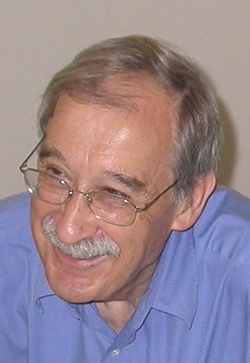 Professor Ray Guillery
Professor Ray GuilleryWe are delighted to announce that Professor Ray Guillery has joined the Unit as Honorary Emeritus Research Fellow. Ray Guillery is a neuroanatomist who entered University College London as a medical student in 1948 and taught there for 11 years, moving in 1964 to Madison, Wisconsin, where he helped to establish a new graduate neuroscience programme. In 1977 he moved to the University of Chicago to lead another new graduate neuroscience programme and in 1984 returned to England as Head of the Department of Human Anatomy at Oxford. He helped to continue and strengthen the interest in the CNS and encouraged developmental research. He retired in 1996 and moved back to Madison to a small research programme and some teaching. In 2006 he moved to Istanbul to do research at Marmara University and to be close to his daughter and grandchildren. He has studied the hypothalamus, the visual pathways and, most recently, the thalamus. He was a pioneering electron microscopist and clarified the synaptic organization of the lateral geniculate nucleus. His focus on the lateral geniculate nucleus led to his recognition of the mechanisms underlying the development of structural abnormalities in the visual system of albino animals. With Murray Sherman he has formulated an influential concept of thalamo-cortical communication, which he continues to develop. He was the founding editor of the European Journal of Neuroscience.
- Unit4 Jun 2010
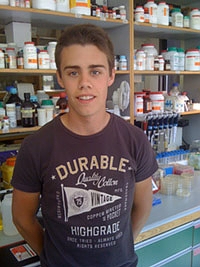
We are glad to welcome second year medical student Tobias Beusnard-Bee from The Queens College, who is going to work in the McIlhinney Lab on his Final Honours School research project under supervision of Dr. Perestenko. Toby will be working on mutagenesis of mouse N-copine and testing its calcium-dependant translocation in cultured mammalian cells and hippocampal neurons.
- Unit2 Jun 2010
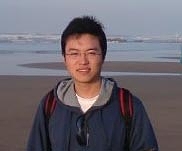
We are pleased to welcome Mr. Gengyu Li to the Unit. Gengyu is a MSc student in Pharmacology at the Hertford College and he will be a DPhil student from Oct 2010 in the group of Dr Marco Capgona. Gengyu will characterise the spatial distribution of synaptic GABAergic responses and explore their functional role in cellular integration.
- Unit1 Jun 2010
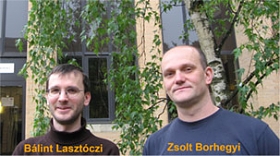
Bálint Lasztóczi graduated as a Biologist in 2000 at the Eötvös Loránd University of Sciences in Budapest. As an undergraduate his main research interest was the function and the pharmacology of voltage-dependent calcium channels. Continuing in the Chemical Research Center of the Hungarian Academy of Sciences in Budapest he studied the pathophysiological mechanism underlying high frequency oscillations and their role in the generation of epileptic activity in brain slices. After gaining his PhD in 2006 he was the Blaschko Visiting Research Fellow and a member of the Unit between 2007 and 2009 where he worked with Thomas Klausberger and Peter Somogyi on the role of identified CA3 hippocampal interneurons in network oscillations. At present he is postdoc in Thomas Klausbergers group at the Center for Brain Research, Medical University of Vienna. Zsolt Borhegyi started his scientific work in his undergraduate years in 1991 in Prof. Tamas Ferund's lab at Budapest, and his main focus during this period was the synaptic organisation of the hippocampal network and its subcortical connections. After his graduation as a biologist in 1995, he spent almost a year in Csaba Leranth's lab at Yale University, New Haven and later in 1998 a year in Gyuri Buzsaki's lab at Rutgers University, Newark. He defended his PhD thesis in 2001 on the connectiviy of the medial septum, supramammillary nucleus and the hippocampus. After a short time spent on the investigation of drug treatment resistent human hippocampal samples, he started juxtacellular recordings medal septal pacemaker cells and conductad a most detailed anatomical analysis of septal neurons. From October 2009 he joined Thomas Klausberger in Vienna and started to work on the function and connections of the prelimbic cortical area.
During their visit Bálint and Zsolt will collaborate with Damien Lapray and Katja Hartwich.